Variable Geometry Bet
However, the leadership of the Air Force increasingly sounded notes of discontent towards the "hope and support of IBA." More often than others, there were complaints about the insufficient combat effectiveness of the Su-7B, primarily due to the low level of the onboard aiming and navigation equipment. The capabilities of the aircraft systems that the pilot had for solving the combat mission were assessed as low shortly after the aircraft was accepted into service. In fact, the Su-7B provided combat use only in good weather conditions with visual visibility of the target and, mainly, in the daytime. In addition, with the reassessment of the role of nuclear weapons and the recognition of the importance of conventional means of fire destruction (bombs, NAR, aircraft guns), the question arose again of its combat effectiveness, which directly depended on the accuracy of the use of weapons. The task was formulated simply: to hit a target, it was necessary to detect it in time, and then aim and deliver a precise blow (especially when attacking a small-sized protected object that required a direct hit - tank, armored vehicles or shelter). At the same time, reaching the target itself was a problem, because navigation equipment on domestic fighter-bombers was not rich in those years - a gyromagnetic and automatic radio compass, which helped to maintain the direction on the route. Possessing on the Su-7B only the KSI course system and the ARK-54I radio compass, the pilots had difficulty navigating, and the AP-28I1 autopilot, designed to facilitate piloting, was allowed to turn on at least 1000 m in accordance with the instructions, and he could only stabilize the vehicle by roll and pitch.
According to estimates made in those years, the likelihood of a successful attack from the first approach on small targets did not exceed 0,1-0,2. This is also proved by the practice at the exercises and during live firing. The pilots were confused even at the landfills, among familiar surroundings, where the position of targets was usually known in advance on the map. The performance characteristics of ASP-5H and PBC-2, which directly influenced the impact of the impact, left much to be desired.
The low combat effectiveness of the aircraft, which was a strike type in front-line aviation, did not suit the customer. Already in the 1961 year, when adopting the Su-7B, the Air Force leadership insisted on introducing into the text of the Government Resolution a task to develop an aircraft modification capable of combat operation at any time of the day and in adverse weather conditions. The basis of the modification of the all-weather fighter-bomber was to be the new aiming and aerobatic equipment, the main contractor in the development of which was the leading domestic organization on this subject - Leningrad State Radio-283 of the State Committee on Radio Electronics, from 1965, transformed into scientific research institute RE, and then into NPO Leninets ". Already during the preliminary design, it turned out that the dimensions and weight of the future system go beyond the limits of the layout volumes of the Su-7B, where neither the search locator nor the aiming equipment could be entered. The search for a solution led to the revision of the entire proposal for the modification and development of a new, larger machine. 24 August 1965 of the year issued the corresponding Decree of the Central Committee and the USSR Council of Ministers No. XXUMX-648 on the creation of a “heavy attack aircraft,” as it was then called, an aircraft that later turned into the successful and popular front-line bomber Su-241.
Nevertheless, the question of the full replacement of the Su-7B was not removed. Moreover, the Air Force leadership considered this topic as one of the most pressing reasons for a number of reasons. In addition to the unsatisfactory level of the target equipment, which remained unchanged during all the years of service of the aircraft, the military drew attention to the insufficient range of the aircraft and poor takeoff and landing performance. The high consumption characteristics of the engine, which literally devoured kerosene and caused the aircraft’s reputation as a “jet tube” to which the fuel flew, as well as a significant specific load on the wing, which became the price for high-speed and dynamic characteristics, most negatively affected the range. During the hour of cruising on the Su-7B dialing, 3950 kg of fuel was consumed (with the capacity of the internal tanks 2760 kg), which is why during the operation, almost all flights had to be carried out using the PTB.
The situation with the landing qualities of the Su-7B looked even more alarming. The heavy aircraft, the normal take-off weight of which was over the 12 t, was difficult to pilot and had the reputation of a strict machine, unsafe in these modes (especially for the low-trained pilot). With the loss of control over the angle of attack, the Su-7B was prone to stalling at speeds less than 350 km / h, which made it necessary to land at significant speeds and precisely “grind” the car that was carrying along the final glide road was not an easy task. The situation with the safety of flights on the Su-7B has been repeatedly assessed by the Air Force Commander-in-Chief as critical, and in the new versions of the Su-7BM and Su-7BKL the aircraft only became heavier, which did not have the best effect on its takeoff and landing qualities. Air Marshal K.A. Vershinin in his report on the results of 1965 of the year directly indicated that Su-7B more than double the MiG-21 in accident rates. With an average flight time of less than 80 hours, over the year, X-NUMX Su-17B were broken down in accidents and disasters - every thirteenth of the 7 machines then in operation.
The increased take-off and landing speeds also made the hopes of strike aviation work from field airfields untenable. Su-7B required airfields of considerable size with a concrete coating, and for them the length of the strip was longer than that of any other type of front-line aviation combat vehicles, including the Yak-28 bombers. Rearmament to "dry" almost everywhere was accompanied by re-equipment of airfields, elongation and expansion of the runway and taxiways. The high cost and complexity of the arrangement of air bases in this matter were not decisive then. Military construction was a matter of national importance, and every year, Voenproekt delivered more and more airfields of the 1 and 2 classes.
It was obvious that the large airfield hubs with parking lots, warehouses and warehouses would become the primary goal in the event of war. It was not possible to hide or disguise such notable objects (although steps were taken to build underground airfields), and their position was well known that made the airbase an attractive target for an aviation or missile attack of the enemy, which would ensure superiority, "clearing the sky." This is confirmed by recent examples of another Middle Eastern war, in June 1967 of the year, which began with Israeli air raids on Arab airfields. The vehicles that were parked became excellent targets for the attackers, who managed to destroy the 416 Arab planes on the first day. 393 of them were shot on the ground, and not having time to rise into the air. The Israelis themselves did not hide the fact that the success of the campaign, which took only six days, they ensured in the very first hours with surprise and precise strikes.
The task of destroying the airbases of a potential enemy has become an indispensable part of strategic plans. Covering their airfields by air defense forces did not solve the whole problem, because the runways, parking lots and airfield facilities were extremely vulnerable even to a single plane or a missile strike. The output, in the literal sense of the word, was the timely dispersal of aviation into alternate aerodromes, unpaved lanes and suitable sections of the highway. For each air regiment it was supposed to have several such field sites. If the enemy could still deliver the first strike and damage the home aerodromes, the aviation forces that retained their combat capability should have had the opportunity to rise from half-destroyed lanes, to fly and work with spare bases, hastily prepared and of limited size.
Having determined, the Air Force command put forward the requirements: front-line combat aircraft must meet the condition of basing on unpaved airfields with a band of no more than 400 m. The take-off accelerators used on some land vehicles, huge braking parachutes and landing gear for aerofinishers did not solve the problem radically, as well as using the system with landing gear. border layer, reducing stalling speed and landing speed, and ski chassis, designed for work with the ground. All these constructive measures have not taken root in the front-line operation.
High hopes were pinned on the use of vertical lifting engines, which were switched on during takeoff and landing and unloaded the wing of the aircraft, which acquired the qualities of an FOC - a steeper climb curve and landing glide, low takeoff and landing speeds and, accordingly, a minimum run-up and mileage. In the future, the development of this idea promised the appearance of combat vehicles with vertical take-off and landing, not needing stationary airfields and capable of covertly operating from forest fields, disguised as ravines, grenades and even urban areas.
A reflection of the concept implemented in the framework of the program to improve the take-off and landing properties of front-line aircraft, adopted in 1964, was built in OKO P.O. Sukhoi T-58VD ("vertical engines") and Т6-1 (the first prototype of the future Su-24), as well as the aircraft design bureau A.I. Mikoyan "23-01" and "23-1 1".
Indicative of the priority of the program was that the future MiG-23 in its first performance was worked out precisely in the version with lifting engines. After a series of experiments, the idea was recognized to be unpromising: the inclusion of lifting engines led to a rebalancing of the aircraft, which sharply changed its stability and controllability in already complicated modes. When landing and at low altitudes, there was a strong suction of gas jets from the ground, pulling the plane down. It was possible to overcome it only by increasing the thrust of the main engine to "maximum", and even afterburner, accelerating the aircraft and intensively using fuel. The mere presence on board of a package of lift engines "eaten away" and without that limited internal volumes, forcing to cut back on fuel and obstructing the placement of the target equipment. The weight efficiency of such a scheme with a few hundred kilograms of overweight additional engines was low, and in cruising flight, inactive engines became a burden that adversely affected the machine's characteristics - high-speed, maneuverability, duration, flight range and payload. As a result, the direction was recognized as a dead end, and after several dozen test flights the program was curtailed. Lifting engines took root only on deck-mounted vertical take-off and landing aircraft, where they compensated for the insufficient thrust of the main power plant and design features, countering the removal of thrust far beyond the center of gravity of the aircraft.
With the development of supersonic aircraft, another circle of problems was revealed that directly influenced their combat effectiveness. The speed seemed to solve many issues at once - the approach time was reduced to the target and the impact speed increased, the swift and sudden attack reduced the time spent in the target area and contributed to survival, compensating for the lack of armor and other constructive protection measures that were hurried away with the assault aircraft . In the USSR, experiments were also conducted on the effects of the shock wave of a low-flying supersonic aircraft on the living force, structures and agricultural objects of the enemy. A supersonic fighter-bomber could get away from pursuit and had, at least, not the worst odds in aerial combat with enemy aircraft. However, the pursuit of speed brought unexpected costs - the pilots of the "supersonic rocket carriers" experienced difficulties in orienting in flight, especially at low altitudes, and in detecting targets. It was here that the second side of the speed, for which the current was sought and which so ungratefully “revenged” for its admirers, opened. Indeed, it is one thing when “The roar and crash drown everything — jet planes rush in the sky,” and another, when it is necessary to find a small-sized target on the battlefield, and often well disguised.
... The outlined trend was confirmed during the development of combat use at training grounds and exercises, where the task was sometimes disrupted due to difficulties with navigation, search, recognition and accurate identification of the object of attack on the area rushing down. Even when you went straight to the target, lying among the familiar target field of the landfill, it was not easy to meet the fleeting contact seconds, which were often not enough to build a combat maneuver, aiming and hitting. At a speed of 1000 km / h in 3-5 seconds, the minimum required for aiming, the plane jumped a kilometer and a half. Bombs now and then flew past targets, not to mention the fact that the task was complicated by the improvement of air defense systems and the saturation of the frontline with them, which also had to be taken into account. In case of a miss, a second call broke the entire effect of surprise, threatening to substitute the attacker under fire by anti-aircraft gunners.
The Berezina exercises held in 1969 in Belarus, in which several IBA regiments participated in the Su-7B, MiG-21 and Mi G-17, had a loud resonance. When analyzing the results of the exercise, the leadership of the Air Force drew attention to an unexpected fact: "... ground targets were struck only by MiG-17 aircraft, while MiG-21 and Su-7B were unable to accomplish this task. Representatives of the aircraft design bureau and The 30 Central Research Institute of Defense, which was in charge of general military aviation construction issues, came to the following conclusion: it was the ability to fly off the ground at a slower speed, carrying out combat maneuvering over the target at speeds of 500-600 km / h, makes Airplanes are a more effective weapon for assault strikes. Fire damage has become more accurate, and good maneuverability (and not just speed, as was recently thought), together with the use of extremely low altitudes, become a means of increasing chances in confrontation with air defense.
Confirmations of this came from the Middle East, where Arab pilots were in no hurry to abandon the subsonic MiGs, often preferring them to modern fighter-bombers. Significant was the fact that having good maneuverability, ease of piloting and excellent visibility from the cockpit, the MiG-17 was widely involved in the fight against enemy air defense systems, including air defense systems. A small and nimble aircraft proved to be a difficult target for anti-aircraft gunners: MiG-17 pilots performed an 2-3 approach to the target, while for Su-7BMK a second approach was considered unacceptable due to the greater risk and if allowed, only in the absence of anti-aircraft fire. In the experience of the three-year skirmishes of the Egyptian-Israeli “war of attrition”, the level of combat losses of the MiG-17, which were used more intensively than their supersonic successors, turned out to be significantly lower: from July 1967 to August 1970, when the ceasefire agreement was signed , during the strikes against ground targets, only four Egyptian MiG-17 against 16 Su-7BMK were shot down.
The solution was a multi-mode combat aircraft that would combine good take-off and landing qualities with high flight characteristics throughout the entire range of speeds used - from high supersonic in flight, overcoming air defenses and breaking through to a moderate target when striking, while maintaining good handling and maneuverability accuracy of fire damage. The task changed the previous approaches, when the "main" characteristics were put in the head, as it was considered, determining for a combat vehicle of this class and achieved for limited flight modes (the same speed for a fighter and a strike aircraft or altitude for an interceptor). The versatility of the aircraft would also provide an increase in its combat effectiveness, taking into account the variety of tasks and conditions of combat use, allowing for the maximum benefit to use both the existing fleet, and various means of destruction and tactical techniques.
The main task in creating such an aircraft, in general, was to ensure a wide range of speeds and an increase in the ratio of the maximum flight speed to the landing one. The parameters of the main bearing surface - the wing of the aircraft - were determining. The wing of a small sweep (ideally straight), of considerable thickness and elongation, which would have the highest values of lift coefficient and critical angle of attack, was optimal for ensuring high takeoff and landing qualities and favorable bearing characteristics at cruising speeds.
However, the thick straight wing was distinguished by high resistance, the wave and inductive components of which sharply increased with increasing speed, and the occurrence of local shock waves at transonic speeds sharply reduced the aerodynamic quality of the aircraft. Exit to supersonic for an aircraft with such a wing was almost impossible due to the increase in resistance, manifested in the form of a “wall” of compressed air - a direct shock wave that “sat” on the leading edge.
The increase in sweep delayed the "wave crisis", increasing the speed, however, it entailed the deterioration of the bearing properties, longitudinal and lateral stability and controllability. In a natural way, the question of achieving the required speed range in all operational modes was solved by changing the sweep in flight, "adapting" the aircraft to the flight conditions - moving the cantilevers backward with increasing sweep at high speed and turning forward, approaching the straight wing on takeoff, landing and maximum flight range when maximum aerodynamic quality was required.
With the change in the sweep of the wing, all its parameters defining the aerodynamic characteristics changed, which is why such a scheme was approved by the name “wing of variable geometry” (CIG), which more fully corresponds to the essence of the decision. When the wing was deployed ("released"), its span, elongation, relative thickness, radius of the nose of the profile and, to a lesser extent, the area increased, and at the same time favorable conditions were created for the take-off and landing mechanization that is most effective on such a bearing plane and allowing for an additional omission the lower limit of the range of operating speeds. When folding ("cleaning") the wing, part of it went inside the fixed structure - the center section, reducing the bearing area, washed by the flow, elongation and relative thickness, and the sweep approached the optimum for a given speed. With the development of tactical covert breakthrough to the target and impact from low altitudes, it was significant that with a decrease in scope and an increase in the wing load, the impact on the aircraft of atmospheric disturbances, usually near the ground, turbulence, gusts, ascending and descending currents causing the turbulence , at high speed difficult to carry and crew, and machine. Having folded the wing, the aircraft acquired compact forms, was less subject to shaking and received tangible benefits in terms of maintaining the health and efficiency of the pilots.
With all the attractiveness of the solution, the problems associated with it were no less obvious. In addition to the issues of aerodynamics, changes in stability and controllability, the difficulties of a constructive and technological plan were put forward - ensuring the movement of consoles, controlling and synchronizing their deflection, maintaining the required strength and rigidity of the moving structure and, especially, transferring loads (remove multi-tonne forces and moments perceived by the whole power circuit, had one turning point, besides being small in size and determined by the building height of the wing, literally centimeter).
Experiments with sliding and slewing wings were conducted in aviation since the 30-s, but practical interest to them has matured with the development of supersonic speeds and the appearance of related problems. The effectiveness of the CIG became noticeable with a variety of operating conditions and operating speeds, which the machine should satisfy. The problem needed to be resolved, and work on the CIG theme was launched in several countries at once. In the 50, the X-5 with the CIG was tested in the United States, which was commissioned by the Air Force as a prototype light attack aircraft, and then an experimental XF10F-1 fighter for the Navy. Both cars are not out of the test stage. At the beginning of 60- x. in the United States began to implement a new project, developing a multi-purpose TEC fighter (later F-111), and a few years later, they began similar projects in the USSR and France.
Starting work ahead of competitors, the Americans invested huge sums in the F-111 project. To cope with the task quickly enough helped as the experience of previous attempts 50-ies. (Then KIG tried to adapt for aircraft deck aircraft, where the problem of take-off and landing characteristics was always paramount), and the deployment of an extensive research and experimental base with many test benches, field experiments and tests of materials, design and technological solutions. Only wind tunnels spent more than 21000 hours, which corresponded to 2,5 years of hard work. In the air, the new car went up two years later after the order was issued - in December 1964 of the year, and already in 1967, the first serial F-111 entered service. The plane turned out to be one and a half times heavier than the F-4 Phantom II, cost three times more and turned out to be literally “golden” —the kilogram of the mass of its design was about 1968 dollars in 330 prices, which was much more expensive than any other car. The latest F-11 1s have risen to the “unit price” to 765 dollars per kilogram (for the Phantom II, this figure was about 180 dollars). The multi-purpose F-111 in the United States was followed by a carrier-based fighter with a CIG F-14 Tomcat and a strategic bomber B-1.
Leaning French at the time refused to adopt the aircraft with the CIG, finding the decision excessively complex and expensive. Experimenting with the Mirage G and G.8 fighters at the start of the 70s. turned down the program. In England, they completely abandoned the construction of such machines only on their own, confining themselves to testing models at the stage of development work .... With the joint efforts of the Europeans, from 1970, they set about creating an airplane with CIG under the program MRCA-75. The result of the work of the aircraft builders of England, Italy and Germany was the Tornado multipurpose two-seat fighter, the first prototype of which was circled in the summer of 1974 ...
In the Soviet Union, things were taken on a much larger scale, achieving impressive results. The fact of the appearance of the American F-111, supposed to be adopted by the Air Force and navy as a universal aircraft - a multi-role fighter-bomber, carrier-based interceptor, reconnaissance and strategic bomber. The planes, which were amazing in capabilities, well-armed and highly automated, were planned to be purchased by the Americans in quantities of thousands, and soon after being adopted, they gained a reputation as a truly belligerent machine, having undergone military baptism in Vietnam (although out of six F-111 sent there during three months were shot down). The feeling of the challenge was all the more zealous in that there was nothing to oppose “aggressive imperialism” - as A.V. Vershinin stated in his report to the Commander-in-Chief of the Air Force, “in the Soviet Union by 1965 the results of R&D on aircraft with a variable geometry wing are extremely insignificant” . They began to correct the backlog by quick and decisive methods, for which almost all design bureaus engaged in combat aircraft received appropriate tasks, from interceptors to long-range bombers.
To provide solutions to the problems of CIG, dozens of design bureaus and scientific research institutes of the aviation industry and related departments were involved. Special contribution was made by the research of TsAGI specialists, where G.S.Byushgens, G.V.Aleksandrov, S.M. Belotserkovsky and other leading aerodynamics, who performed an enormous amount of fundamental calculations and experiments, on the basis of which TsAGI strongly recommended the introduction of CIG. It was especially emphasized that such a scheme would be the most promising for a multi-purpose combat aircraft capable of solving various tasks, acting both as a front-line fighter and low-altitude strike aircraft. The purpose of the IBA aircraft such opportunities were just right.
Plans were defined, tasks were set, and by the beginning of the 70-ies. combat aircraft with KIG for the main types of air forces, both for front and long-range aviation, were built and put into production. The assessment of "science" fully corresponded to the views of the Air Force command, and the new direction assumed the character of the mainline, receiving strong support in all instances. Only two countries in the world — the USSR and the USA — could deploy full-scale programs for re-equipping the Air Force with the latest technology, because assigning special importance to the task, because to give way in the race in those years was unthinkable. The potential adversary should, in the shortest possible time, counterpose the answer - qualitative and, if possible, more effective.
The first aircraft in the USSR with KIG was the C-22I developed in the OO Sukhoi design bureau, which was the result of a modification of the Su-7B. Soon, under the name of Su-17, he was put into service as a fighter-bomber and from the 1969 year began to enter the Air Force. The MiG-23 became the main fighter aircraft, the Su-24 was a front-line bomber, long-range aviation began to change to the Tu-22 (and later received a heavy Tu-160 bomber).
As already mentioned, in addition to Su-7B and Su-17, MiGs were also armed with IBA, however, they were reclassified to fighter-bombers according to the "residual principle": when the machines were obsolete, significantly lagging behind more modern types and modifications, they were transferred to strike aviation, where the MiG-17 and MiG-21 were a significant part.
Being predominantly loaded with work on fighter topics for the Air Force and Air Defense Aviation, A.I. Mikoyan Design Bureau did not practically work out developments in the interests of IBA and BA — areas with its own specifics, range of issues, interests and, not least, relations (the exception was intelligence - shock modifications of the MiG-25, adapted for altitude bombing). Aviation Industry Minister P.V. Dementyev
The new Minister of Defense, A. A. Grechko, who replaced R.Ya. Malinovsky at this post in 1967, also held realistic views on the role of the Air Force, insisting on the development of their strike component, including battlefield aircraft. With this proposal in the spring of 1969, he turned to MAP, who soon announced a competition for an “attack aircraft” with the participation of the Yakovlev, S.V. Ilyushin, A.I. Mikoyan, and P.O. Sukhoi Design Bureau. I must say that by this time the diversification of the subject of the strike aircraft had not yet been properly formed. The assignment to the “attack aircraft” assumed the characteristics and capabilities wider than the battlefield required by the aircraft in the usual sense. In accordance with it, the proposed projects were quite different types of shock machine, as its creators saw, from a front-line bomber-missile carrier, embodying the latest advances in aircraft manufacturing, radio electronics and serving as a counterweight to the F-111 (Su-24), and a high-speed fighter bomber with a wide range of aiming and navigation equipment and the latest weapons (like Western tactical fighters) to the actual "troop attack aircraft" - subsonic, maneuverable, well s protected and acting primarily in the interests of the army (as was evident from the name).
The projects were presented to the Scientific and Technical Council of the IAO, where the developments of the OKB A by I. Mikoyan and P.O. Sukhoi were considered promising. The Yakovlev project, which was a variant of the same Yak-28 with a crew cabin reservation, and again proposed by Ilushin Il-40, caused many complaints and were rejected as underdeveloped - primarily by the level of specialized target equipment and armaments.
At the second stage of the competition, the OKB A.I. Mikoyan and P.O. Sukhoi competed among themselves, defending not only the projects, but also their own vision of the strike aircraft of the battlefield. Among other options, the “Sukhovtsy” considered a smaller version of the Su-17 with CIG and an armored cabin proposed by AM Polyakov, but ultimately, the project of Yu.V. Ivashechkina is a subsonic light military attack aircraft of the LVSSh (future Su-25), "attracted" not only and not so much to the leadership of the Air Force, but to the Commander-in-Chief of the Ground Forces I.G. Pavlovsky. The army general with a military background immediately appreciated the concept of the aircraft and even insisted on its transfer from the Air Force to the ground forces, where attack aircraft would always be at hand.
The Mikoyan projects submitted for the contest were variations on the theme of the honored MiG-21, which promised time savings and cheaper planes and, in general, met the requirements of the customer who insisted on a supersonic machine at a speed of at least 1200 km / h near the ground (this condition in TTT was dictated by ensuring the survival of the aircraft during an air defense breakthrough and was based on data on the capabilities of the main Hawk air defense system in NATO armies, whose combat effectiveness dropped sharply at the indicated speeds of low-altitude targets) ...
Initially, the Design Bureau proposed the conversion of a simple and reliable MiG-21 fighter into a MiG-21Sh attack plane by the shortest route. It was supposed to get by with “little blood” - to install on the MiG-21 a new wing of a larger area with six weapon points and a new aiming and navigation equipment. However, calculations and estimations have shown that it is unlikely that the problem can be solved head-on with the required efficiency. It was decided to significantly upgrade the design of the "twenty-first", to pay more attention to issues of survivability and weapons. Work on the new theme, which received the index "27", was conducted immediately on two projects: the MiG-27Sh and "27-11".
The first machine was created on the basis of the MiG-21, but as a result, only the tail part of the fuselage with the tail remained in the new aircraft, the rest was projected anew. The MiG-27Sh received a low-spaced trapezoidal wing of a large area, side air intakes, besforsazhenny engine, a short nose and a cabin with a good view. To protect small arms and shell fragments from fire, the cockpit was designed fully armored. The armament of the vehicle was represented by a double-barreled 23 mm gun GSH-23 (AO-9), bombs and a NAR weighing up to three tons, placed on nine outer suspension points.
The basis for the second project was the aircraft "21-11", better known as the MiG-21I or "Analogue". It was created to test the animated wing of a supersonic Tu-144 passenger liner and was made in two copies. Tailless with a lively wing of a thin profile that had a conical twist, was attractive because of its high aerodynamic quality, less resistance and balancing moments, which made it a good solution in meeting the conflicting requirements of aerodynamics and structural strength. The wing twist made it possible to tighten the flow stall in the end sections to large angles of attack, improving its bearing qualities at takeoff and landing speeds and increasing the efficiency of control. The scheme also differed in a low specific load on the wing, which allowed it to carry significant armament, increased the maneuverability and take-off and landing characteristics of the shock machine (the “analog” produced the minimum evolutionary flight speed of 212 km / h).
The tests of “Analog” gave positive results, and a new wing was decided to be used on a fighter-bomber. Nevertheless, the fuselage "27-11" also became completely different. Side air intakes, an armored cabin and a new form of the bow were used, in which it was supposed to deploy electronic warfare equipment (EW) and the guidance system of air-to-surface guided missiles. Compared to the MiG-21, the chassis was strengthened and made it possible to operate the heavier vehicle from field airfields. The power plant to improve reliability consisted of two turbojet engines, located side by side in the rear fuselage. Armaments weighing up to three tons were planned to be placed on eight underwing and four ventral holders.
But both cars remained in the form of sketches and models. By that time, the basis of these projects, the MiG-21, was no longer the last achievement of design thought. The modernization, which left little of the prototype, actually poured into the creation of a new aircraft, and the promised combat effectiveness did not keep up with the costs and did not provide the desired quality breakthrough. The customer also expressed dissatisfaction with the diversion of forces and means from the priority subject - the MiG-23 aircraft with a variable geometry wing, whose broad perspectives, as it was then seen, solved many problems at once. It should be noted that the leadership of the Air Force was not completely satisfied with the state of attack aviation: adopting the Su-17 only solved part of the problems, in fact only allowing a slight increase in the flight range and improved takeoff and landing qualities compared to the Su-7B. The combat effectiveness of the Su-17, carrying almost the same set of aim-navigation equipment and weapons as the Su-7BLK, remained almost at the same level, so the expected qualitative and quantitative growth of combat capabilities was not immediately achieved. The OKB Sukhoi OKB chose a proven way to gradually modify the machine, simplifying problems with the continuity of new equipment in production and operation, and reducing technical risk according to the principle “the best is the enemy of the good”, allowing you to “pull up” the aircraft following the ever-growing demands of the customer.
The designers of Mikoyan undertook a different course, laying a lot of radical innovations in the new car that provided priority in many areas. MiG-23 promised to be not only multi-mode, but also multi-purpose. His capabilities looked so promising that they could count on the emergence of a whole family of combat vehicles, from an interceptor and a front-line fighter to a scout and a strike aircraft.
New solutions
Great hopes were placed on the MiG-23: PS Kutahov, who was appointed 1969's deputy to the post of Air Force Commander in the year 1, himself came from fighter jets and did not hide his position to the "twenty-third", openly stating that he recognizes only MiG-23 from the new aircraft. In the opinion of the Commander-in-Chief, the aircraft was to become the main combat vehicle of military aviation and its modifications should be armed both with fighter and anti-aircraft defense aircraft, as well as with IBA and reconnaissance units.
I must say that the position of the leadership of the Air Force was based not only on personal affection. In addition to the scheme, generally recognized as promising at the time, and promising flight characteristics, among the advantages of the MiG-23 was a very modern onboard equipment. One of the problems that had arisen by that time was the psycho-physiological overload of the pilot, especially manifested in low-altitude flights, the need for which, in turn, became apparent. At first it seemed that the main risk was associated with the danger of a collision with the ground and obstacles, which was quite high in high-speed flight.
The first experiments of performing combat missions at low and extremely low altitudes showed that the crew’s rapid fatigue is more significant because of the heavy bumpiness and sudden overloads in a restless atmosphere near the ground and the high workload that requires constant attention and concentration, because the slightest error in piloting over the flying towards the terrain could be fatal. The pilots noted a growing sense of insecurity, anxiety, a large number of miscalculations and an increase in reaction time. In general, these factors even gave rise to the concept of a psychological barrier, when the task, which also required observation of the terrain, landmarks, the actual search for a target and an attack, became problematic. Not less critical for combat effectiveness was the use of weapons in the fleeting seconds of contact with the target. In manual modes, the slightest mistakes of the pilot led to serious misses - it was not accurate to set or not to withstand the design speed, altitude, range or dive angle, so that the bombs flew past the target. So, at a speed of 900 km / h, the delay in dropping a bomb for just half a second resulted in a flight to 125 m; when bombing from horizontal flight, the knob tightened to 1 ° gave the bomb care approximately on 120 m; an error with the determination of the discharge height on 50 m relative to the calculated one turned into an undershoot or a flight to 160 m.
To help the crew should come automation related to onboard systems. It would allow to partially relieve the pilot, relieving him of some of the tasks associated with navigation and piloting, allowing him to concentrate on the main thing - the search and defeat of the object of attack. Requirements for such equipment stipulated the possibility of flying according to the program set up with automatic landing and return to the airfield of landing, control of the aircraft with stabilization by course and altitude, compliance with restrictions on limiting modes, balancing the machine in flight but different modes, performing specified combat maneuvers and solving sighting tasks. The creation of the KN-23 navigation complex for the aircraft was carried out by the Electrosila software, specialized in computing and instrumentation equipment. Mikoyan people already had experience with the similarly designed Peleng system, which was tested and put into operation on the MiG-25RB, where the equipment combined with the CVM 10-155 Orbit ensured automated flight and bombing.
The KN-23 complex had more capabilities, corresponding to the intended purpose and specifics of the fighter-bomber operation - a multi-purpose aircraft with an extensive range of speeds, altitudes and tasks. The main components were the SC-23 inertial heading reference SCR-1, Doppler velocity meter and drift angle DISS- 7 "Search" to the analog calculator in-144, apparatus near the radio navigation and landing RSBN-6S "rhombus-1 R" and air data sensors . The computing and radio engineering part of the RSBN was used as a decisive device in the complex.
Gyroscopes and sensitive accelerometers IKV-1 recorded instantaneous data on the spatial position of the machine, their changes and overloads. DISS-7 gave the current data on flight speed and glide, RSBN-6С allowed to determine the aircraft’s own coordinates relative to the ground beacons and the direction to them. KN-23 was also connected with the ARK-10 automatic radio compass and PB-4 radio altimeter.
The calculator, performing the processing of incoming current data, provided a continuous solution of navigation tasks for navigation in automatic mode, in which the aircraft on the route led to the ACS, or in the director, with issuing the course and distance to the target, the turning point of the route or airfield. When solving the sighting task for bombing, launching rockets and firing from a cannon, the automation of the calculator produced in the sighting complex signals from the angles of heel, pitch, module ground speed and drift angle.
By 1969, the development of the navigation complex was basically completed. KN-23 had a high efficiency for those times: together with the ACS, it allowed to fly along a given route with three turning points (they could also serve as targets), providing a return to one of the four landing airfields, where the system would take the plane down to 50-60 m (the pilot performed the landing manually), ensured stabilization of the regime, position in space and the flight altitude of the aircraft, returning to horizontal flight with loss of orientation at night and in the clouds. For this purpose, the mode "bringing to the horizon", automatic withdrawal from a dangerous low altitude, balancing the machine for roll and pitch, damping vibrations from gusts of wind, turbulence and other reasons, relieving forces on the control stick, as well as performing combat maneuvers, including the exit from attack. When tested KN-23 pilots noted its significant advantages. The automation of the complex freed the pilot from routine work, allowing him to concentrate on targeting and finding the target, simplifying the execution of the attack and significantly increasing the accuracy of the weapon. When operating in automatic mode, the KN-23 ensured that the route passed almost without the pilot's participation; in standby director mode, all that was needed was to track the readings of the instruments — an arrow on the course indicator and the track counter, working them out and accurately taking the plane to the target.
Work on the MiG-23 progressed very intensively. The first prototype aircraft, the 23-11 / 1, took off on May 26, operated by A.V. Fedotov. The son of the General Designer V. A. Mikoyan was appointed the lead engineer on testing. Already the fourth prototype of the 1967 was the 23-23 / 11 aircraft assembled as a MiG-4B fighter-bomber (B is a bomber), and considering that only the third prototype received complete radar equipment and weapons, the shock machine immediately followed the fighter. The MiG-bomber, launched in tests in the summer of 23, differed from the base machine, mainly in the installation of other equipment and weapons. The nose cone under the “fighter” radar sight “Sapphire-1969” replaced the duralumin fairing, and the nose part was occupied by the Sokol-23 aiming system (on the “23-23 / 11” machine still incomplete). The cannon armament in the form of the ventral GSH-4L was retained, but ensuring the placement of a given three-tonne combat load turned out to be a problem (it is worth recalling that such a bomb load was only “on the shoulder” except for the Il-23 and Yak-28 bombers).
Features of the layout of the MiG-23 left the possibility of installing only a small number of holders - two underwing under the center section and, taking into account the centering, two ventral sides of the gun installation. The removal of the suspension units under the swivel cantilevers was refused immediately due to the complexity of solving the kinematics of synchronous rotation when laying and cleaning the wing, and the corresponding thrust and rocking arms would have to be installed in the wing box with inevitable problems of sealing and sealing the wiring.
For the suspension of the required bomb load, we had to use multi-lock tandem bomb holders borrowed from the MiG-25РБ armament. They were placed on a pair of bombs in caliber to 500 kg. Holders mounted under the fixed part of the wing, and with their help, the plane was able to carry up to six "five hundred". In addition to the bombs, the MiG-23B could use NAR UB-16-57 and heavy NAR C-24 units.
The aircraft received a low assessment of testers and military: a significant part of the sighting system was not yet ready, and the view from the cockpit and the operating conditions of the sighting equipment were unsatisfactory for the percussion machine (for example, the down-front viewing angle was only 8,5 ° - less than that of the MiG- 21, which is why the aiming mark, when sighting a target, quickly "sat on the hood", and the target itself disappeared from view). The eight-ton thrust of the P27F-300 engine was rated as insufficient to maintain acceptable take-off characteristics of the car that gained weight. There is also a need to revise a number of design nodes, taking into account the increased loads - first of all, the chassis, "holding" to the limit heavy aircraft, especially taking into account the requirements of basing on field airfields.
Corresponding changes were introduced during the development of the MiG-23Sh modification (Ш - attack aircraft), the avant-project of which was released in the same year. The aircraft was distinguished by a modified nose of the fuselage to improve the forward and downward visibility, the introduction of cockpit armor protection and an improved Sokol-23С aiming system. The project was approved by the customer, and during the discussion, the rationality of the layout and the use of advanced systems and equipment were especially noted. Acquainted with the layout of the aircraft, the military rated the review from the cockpit as the best, not only of all available, but also the newest aircraft (undisguised reproach sounded against the newly adopted Su-17, where the review remained at the level of Su-7Б).
The creation of the aircraft was officially confirmed by the Decree of the Central Committee of the CPSU and the USSR Council of Ministers No. 116 of February 4 from 1970. In accordance with the established procedure 20 on April 1970, the Decision of the Military Industrial Commission (MIC) under the Council of Ministers was held, and in its execution by Minaviaprom 20 on August 1970 of the year issued Order No. XXUMX. The documents were taken "in fact" the construction of experimental machines, marching in full swing.
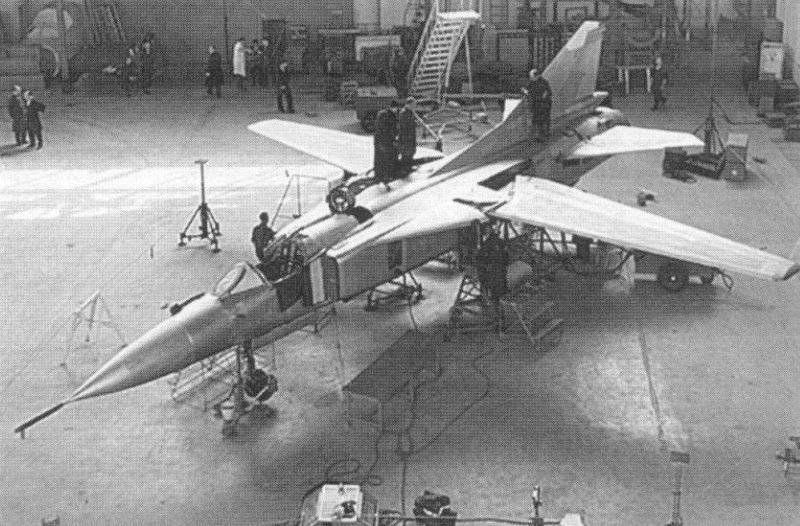
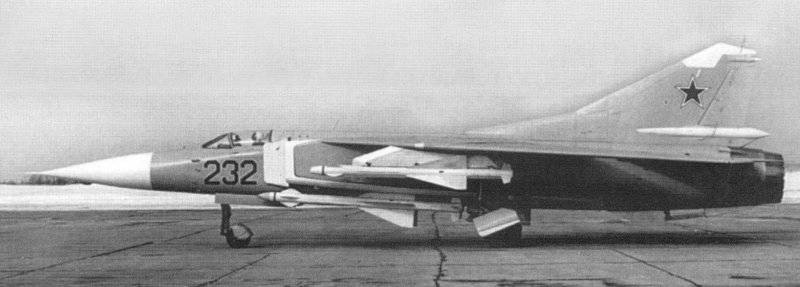
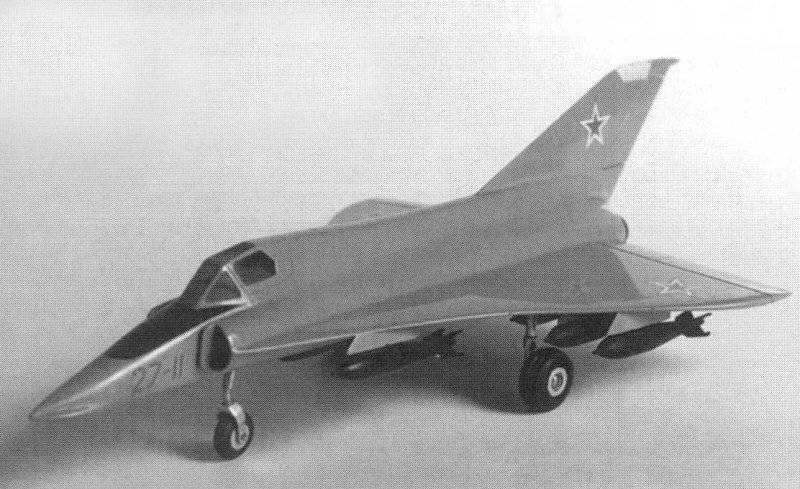
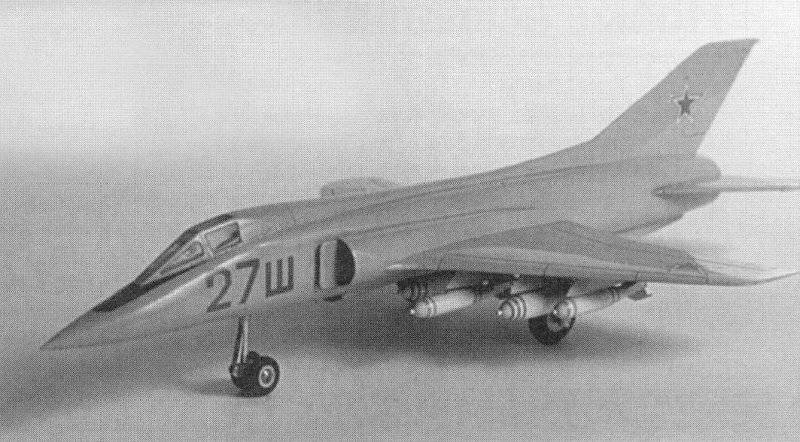
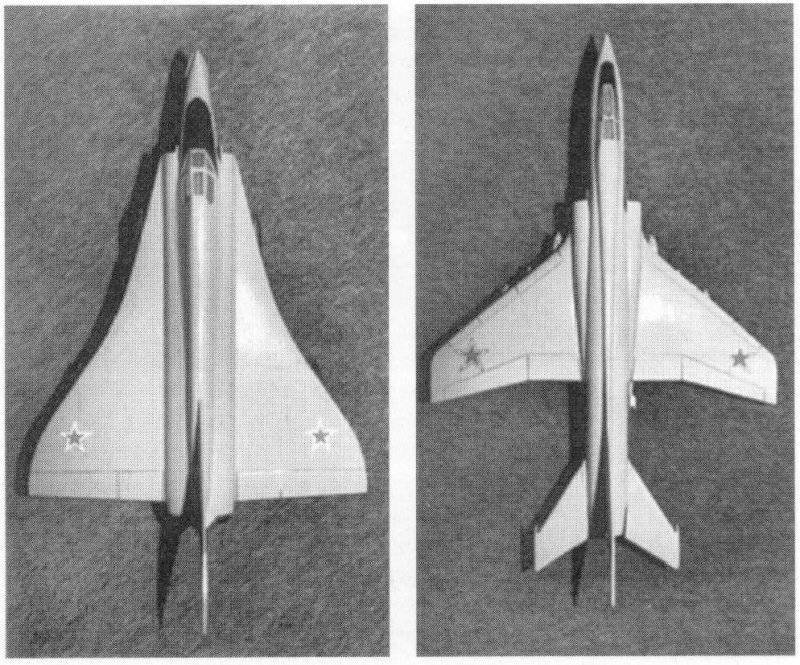

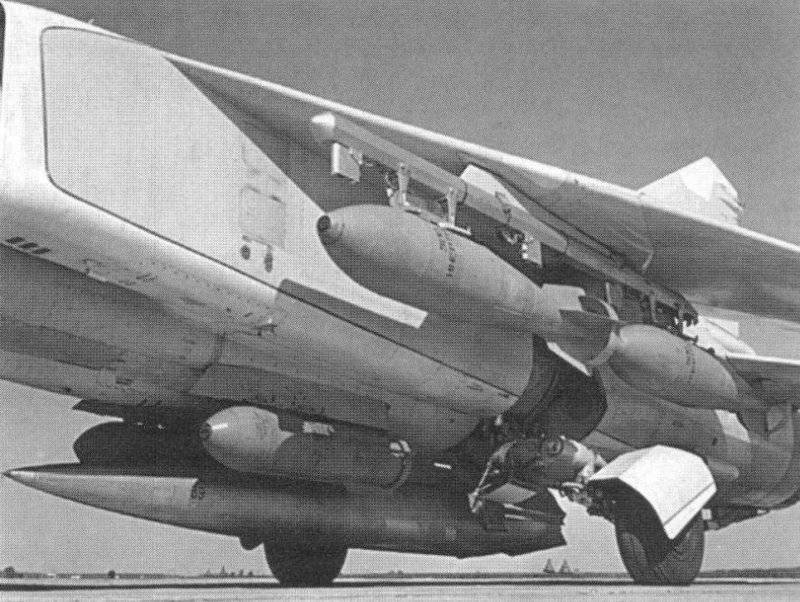
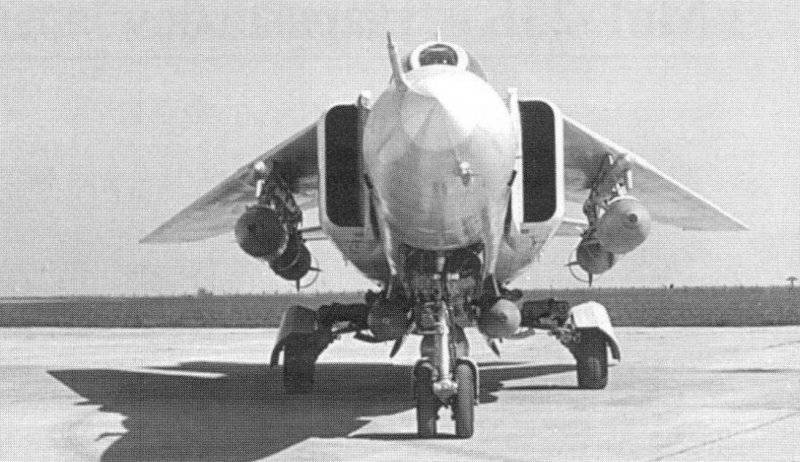
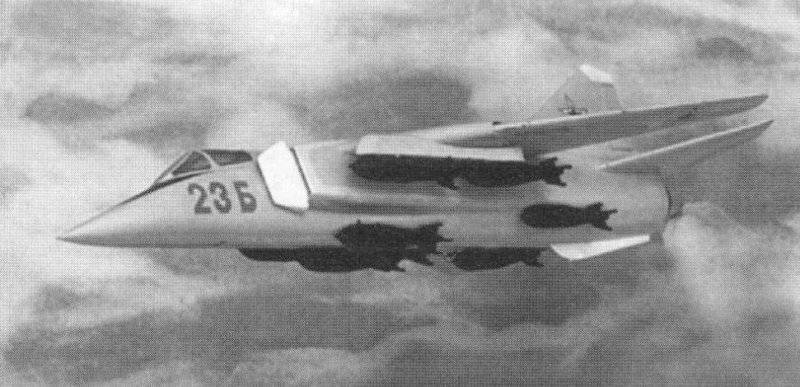
Information